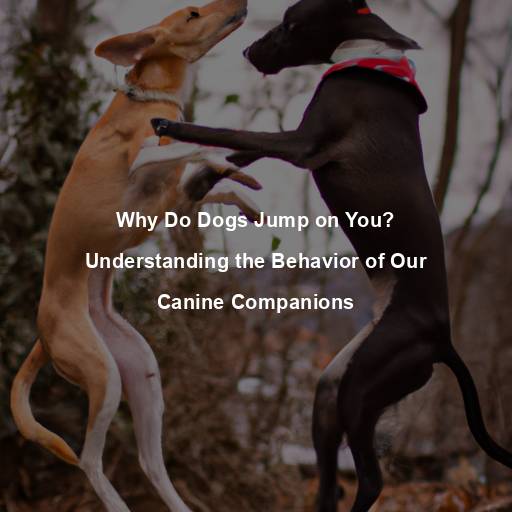Why Do Dogs Jump on You? Understanding the Behavior of Our Canine Companions
Last Updated on November 8, 2023 by Evan
Contents
- 1 The Natural Instincts of Dogs
- 2 The Impact of Training and Socialization
- 3 Possible Misconceptions about Dogs Jumping
- 4 Addressing and Redirecting Jumping Behavior
- 5 The Importance of Patience and Consistency
- 6 Understanding Your Canine Companion
- 7 Managing Excitement with Exercise and Mental Stimulation
- 8 The Role of Consistency in Training
- 9 Understanding Triggers and Implementing Desensitization
- 10 Seeking Professional Help
- 11 Managing the Environment to Discourage Jumping
- 12 Addressing Specific Situations
- 13 The Importance of Positive Reinforcement
- 14 FAQs – Why do dogs jump on you?
The Natural Instincts of Dogs
Dogs are known for their exuberance and enthusiasm, often expressed through their tendency to jump on people. While this behavior may seem adorable to some, it can be overwhelming and even dangerous for others. To truly understand why dogs jump on us, we must delve into the natural instincts that drive this behavior.
The Pack Mentality
Many find themselves bewildered by the perplexing behavior of our furry friends. Dogs, descendants of pack animals, carry within them the intricate tapestry of their ancestors’ survival tactics. Within the intricate social fabric of their canine packs, hierarchies emerge through a display of dominance or submission. So, when a dog unexpectedly lunges towards you, it is an intriguing attempt at asserting its dominance or seeking that coveted attention, as it perceives you as a part of its extended pack.
Seeking Attention and Affection
It’s no secret that our furry friends have their own unique ways of seeking attention and affection. One particular behavior that many dog owners can relate to is the infamous act of jumping. For these highly social creatures, launching themselves towards their humans is a burst of excitement and an undeniable display of their desire for contact and love. It’s perplexing yet endearing how they use this method to initiate interaction and fulfill their insatiable appetite for affection.
The Impact of Training and Socialization
While jumping on people may be a natural behavior for dogs, it is essential to train them to exhibit more appropriate behaviors. Proper training and socialization play a significant role in curbing this instinctive jumping behavior.
Consistent Training
Consistency is key when training a dog. By establishing clear boundaries and consistently reinforcing desired behaviors, you can teach your furry friend that jumping is not an acceptable way to greet people. It is crucial to reward them for calm and controlled behavior, such as sitting or staying, instead of jumping.
Socialization with Other Dogs and Humans
Socialization is a vital aspect of a dog’s upbringing. By exposing them to various environments, people, and other dogs, you can help them develop appropriate social skills. Socialization allows dogs to learn appropriate greetings and interactions, reducing the likelihood of jumping on people out of excitement.
Possible Misconceptions about Dogs Jumping
The world of dog behavior is riddled with misconceptions that desperately need debunking. Tackling these canards head-on will shed light on the captivating world of our four-legged companions and their unique antics. Together, let’s unravel the mystery behind why our beloved pooches have an inexplicable affinity for jumping on unsuspecting passersby. It’s time to separate fact from fiction and embark on a journey of enlightenment.
Misconception 1: Dogs Jump on People to Dominate Them
There’s been a barking-misunderstanding about why our furry friends bounce on us like a pogo stick. Conventional wisdom suggests it’s a power play, but woof, that’s not quite right. It turns out that when Fido jumps, it’s more about their heightened sense of enthusiasm, their craving for attention, or, let’s face it, their inability to hold back those paws of energy.
Misconception 2: Dogs Jump on People as a Sign of Aggression
When it comes to dogs jumping on people, things can get quite perplexing. In most cases, these furry creatures aren’t trying to assert their dominance or show aggression; instead, they’re simply trying to express their friendliness and excitement. However, we must embrace the burstiness of the situation and acknowledge that not all jumps are created equal. Some pups might be displaying territorial aggression or fear-based aggression, which can manifest itself through their jumping behavior.
Addressing and Redirecting Jumping Behavior
As we delve into the perplexing world of dogs jumping on people, it’s time to shed light on the underlying reasons and unravel the misconceptions that surround this common behavior. But fear not, for we have come armed with an array of effective strategies that will help you navigate and redirect this burst of excitement from your furry friends. So, let’s embark on this puzzling journey together and discover the secrets to curbing those leaps with finesse!
Encouraging Alternative Greetings
One approach to curbing jumping behavior is to redirect your dog’s energy towards alternative greetings. Teach them an alternative behavior, such as sitting or offering a paw, as a means of greeting people. Reward and reinforce this behavior consistently, so your dog learns that it is more rewarding and appropriate than jumping.
Ignoring the Jumping Behavior
Another technique involves ignoring the jumping behavior altogether. By withholding attention when your dog jumps on you, you remove the reinforcement they seek. Turn away, avoid eye contact, and refrain from interacting until your dog calms down. Once they have settled, reward them with attention and affection, reinforcing the desired calm behavior.
Seeking Professional Help
When it comes to managing those exuberant moments of our canine companions, it’s essential to recognize that there are instances where seeking professional guidance is prudent. The expertise of a qualified dog trainer or behaviorist can prove invaluable in tailoring a personalized approach to address jumping behavior in a way that suits your unique circumstances. By engaging their expertise, you can develop a well-rounded training plan that effectively tackles this behavior, instilling new and more appropriate habits in your furry friend.
The Importance of Patience and Consistency
Changing a dog’s behavior takes time, patience, and consistency. It is essential to remember that dogs rely on repetition and clear communication to understand what is expected of them. By remaining patient, consistent, and using positive reinforcement techniques, you can successfully address and modify your dog’s jumping behavior.
Consistency is Key
Consistency is crucial when training a dog. Ensure that all family members and visitors are on the same page regarding the desired behavior. Inconsistencies may confuse your dog and hinder progress. By consistently reinforcing the desired behavior and redirecting jumping, you can help your dog understand what is expected of them.
Positive Reinforcement
Unlock the secret to shaping your furry friend’s behavior with the unparalleled power of positive reinforcement. Shower your canine companion with luscious treats, heartfelt praise, and tender affection when they exhibit the desired behavior, be it the elegant art of sitting or the Zen-like art of staying calm. By skillfully associating these enticing rewards with appropriate greetings, you can sprinkle their doggy world with newfound manners and coax them into embracing more sophisticated and refined ways of welcoming guests. Prepare to embark on a journey of canine transformation that will leave tails wagging and hearts bursting with joy.
Understanding Your Canine Companion
Unraveling the intricacies of a dog’s natural instincts and behaviors can provide valuable insights into the baffling phenomenon of why they incessantly jump on people. Through a careful blend of training techniques, socialization, and consistent reinforcement, we can begin to unravel the perplexing motives behind this behavior. It is crucial to remember that your dog’s seemingly exuberant jumping is not an indication of dominance or aggression, but rather a manifestation of their innate excitement and yearning for attention. By employing a combination of patience, empathy, and effective training methods, we can gradually guide our furry companions towards more appropriate and polite greetings, nurturing them into well-mannered beings.
Understanding and interpreting your dog’s body language is crucial when addressing jumping behavior. By paying attention to their cues, you can effectively communicate your expectations and redirect their behavior. Here are some key body language signals to look out for:
Calming Signals
Have you ever noticed that when dogs are feeling a bit overwhelmed or anxious, they tend to show some peculiar behaviors? It’s almost as if they have their own secret language to communicate their distress. These signals can range from yawning to sniffing the ground or even turning their head away. By being attentive to these cues, you can better understand when your furry friend needs a little extra support and redirect their attention towards more relaxing activities.
Reinforcing Calm Behavior
Every pet owner knows the struggle of managing their furry friend’s energy levels, but it’s important to recognize and celebrate those precious moments of tranquility. When your dog displays a remarkable sense of composure, it’s crucial to show them your appreciation in creative ways. Whether it’s a delectable treat, heartfelt praise, or a tender pat on the head, let them know that their zen-like demeanor is highly valued. By consistently reinforcing these moments of serenity, you’ll be nurturing a calmer, more balanced canine companion.
Managing Excitement with Exercise and Mental Stimulation
Getting your furry friend the adequate physical and mental activity they need is key when it comes to curbing their jumping tendencies. By engaging your dog in stimulating exercises and activities, you can help alleviate their excess enthusiasm and reduce their inclination to jump around. Here are a few tried-and-true techniques to keep your pup’s excitement in check:
Regular Exercise
Taking care of your furry friend goes beyond just feedings and cuddles. It’s important to incorporate regular exercise into your dog’s routine, tailored to their specific needs. Whether it’s a leisurely stroll around the block, engaging in playtime filled with toys and excitement, or even trying out some agility training, keeping your pup physically active is crucial. Not only does exercise help them burn extra energy, but it also helps curb those impulsive jumping episodes that can leave you perplexed.
Mental Stimulation
Unlocking your dog’s full potential goes beyond physical exertion. Expand their horizons through the power of cognitive challenges, igniting their intellect and zest for life. Immerse them in a world of puzzle toys, obedience training sessions, and interactive games that tickle their neurons. By embracing mental stimulation, you’ll witness a metamorphosis in their behavior, leaving behind the impulsive leaps in favor of a serene demeanor.
The Role of Consistency in Training
Consistency is vital throughout the training process. Here are some key aspects that require consistency:
House Rules
Make a jump-free zone at home by implementing some paw-some guidelines. Share these pawsitively crucial rules with every household member, guests, and anyone who comes in contact with your furry friend. By consistently reinforcing these boundaries, you’ll steer clear of any canine confusions and ensure your pooch knows exactly what’s expected of them.
Training Techniques
When it comes to training your furry friend, maintaining consistency is key. It’s important to find a training method that resonates with your personal values and commit to it wholeheartedly. Constantly switching between different techniques can lead to a perplexed pup and slow down their progress. By staying consistent with your chosen training approach, you’ll be well on your way to achieving more effective and successful results.
Understanding Triggers and Implementing Desensitization
Identifying triggers that contribute to your dog’s jumping behavior is essential. By understanding these triggers, you can implement desensitization techniques to modify their response. Here’s how you can approach this:
Identify Triggers
Take a closer look at your furry companion’s actions and uncover the enigmatic circumstances or tantalizing cues that provoke their airborne antics. Whether it’s the arrival of esteemed guests, the elusive echoes of resonating sounds, or intriguing gestures that challenge gravity itself, perceptive observation is key. Once you unravel the enigmas behind their soaring proclivities, embark on a journey of gentle exposure therapy to ease their fascination and create an atmosphere of serene equilibrium.
Gradual Exposure
Expose your dog gradually to the triggers in a controlled manner. Start with a low-intensity version of the trigger and gradually increase the intensity over time. For example, if your dog jumps when the doorbell rings, practice doorbell sounds at a lower volume initially and increase it gradually as your dog becomes more comfortable.
Seeking Professional Help
If your dog’s jumping behavior persists despite your best efforts, seeking professional help is a wise decision. A professional dog trainer or behaviorist can provide expert guidance tailored to your specific situation. They can assess your dog’s behavior, identify any underlying issues, and develop a comprehensive training plan to address the jumping behavior effectively.
Positive Experiences
During the critical socialization period, which typically occurs between 3 and 14 weeks of age, exposing your puppy to various people, animals, and environments helps them develop positive associations. This exposure reduces the likelihood of fear or anxiety-related jumping behaviors later in life.
Controlled Interactions
When it comes to socializing your adorable new furry friend, the key is to introduce them to a varied bunch of folks, of all shapes, sizes, and walks of life. This helps your little pupper learn how to approach different individuals without resorting to excessive jumping or frenzied greetings.
Puppy Training Classes
Joining puppy training classes offers a wonderful chance for your furry companion to embrace socialization. Through carefully organized sessions that involve supervised interactions with fellow pups and skilled trainers, your puppy can master crucial social skills while understanding the importance of appropriate behavior. Let this experience pave the way to a well-rounded and socially adept pup!
Managing the Environment to Discourage Jumping
Addressing the issue of jumping behavior requires an environment that exudes an aura of disapproval towards such antics. Let’s explore a few strategies that can help in curbing this behavior.
Ignoring Jumping
When your dog jumps on you or others, it’s essential to avoid inadvertently reinforcing the behavior. Instead of giving attention or pushing them away, turn around, cross your arms, and remain silent. By removing the attention they seek, you discourage jumping as a means of getting your focus.
Teaching an Alternative Behavior
When it comes to curtailing your dog’s exuberant jumping spree, channeling their boundless energy into a more suitable outlet is key. Teach them a verbal cue like “sit” or “down,” and shower them with praise and rewards when they obediently comply. By fostering this desired behavior, you redirect their innate enthusiasm towards a more socially acceptable action.
Using Environmental Management Tools
Utilizing environmental management tools can also be helpful in discouraging jumping behavior. Consider using baby gates or barriers to create designated areas where your dog can greet visitors without the chance to jump on them. This allows for controlled introductions and helps reinforce appropriate behaviors.
Addressing Specific Situations
It’s no surprise that our canine companions can sometimes exhibit peculiar jumping behaviors in various situations. From the excitement of greeting a familiar face to the demand for attention, there are countless reasons why dogs jump. If you find yourself amidst this perplexity, fret not. We have compiled a list of specific scenarios and effective strategies to help you address this burst of energy within your furry friend.
Jumping on Guests
When guests arrive, it is essential to manage the situation to prevent jumping. Consider the following strategies:
Before your guests arrive, make sure to put your beloved furry friend on a leash to ensure a smooth introduction. Lead them to a dedicated “greeting area” designed specifically for calm and friendly interactions. By following these simple steps, you can create a welcoming atmosphere while keeping your dog and guests at ease.
– Ask your guests to ignore your dog until they are calm and sitting. Once your dog settles, guests can offer treats or gentle petting as a reward for calm behavior.
– Consistently reinforce the desired behavior by redirecting your dog’s attention to an alternative behavior, such as sitting or offering a paw.
Jumping on Family Members
While jumping on family members may be more tolerated, it is still essential to address this behavior. Here’s how:
- Consistently enforce the same rules for family members as you would for guests. Encourage your family to avoid reinforcing jumping behavior and redirect their attention to more appropriate greetings.
Looking to curb your pup’s enthusiastic leaps? Take the lead and teach them a nifty verbal cue like “off” or “four paws” to let them know jumping is a no-no. Remember to shower them with praise and treats when they obey the command and showcase their newfound restraint.
The Importance of Positive Reinforcement
When it comes to shaping your furry friend’s behavior, positive reinforcement really takes the cake! And speaking of cakes, let’s dive into the exciting world of curbing jumping tendencies. By employing this tried-and-true method, you can guide your pup toward better manners with a sprinkle of treats, heaps of praise, and a dash of consistency. It’s time to put those jumping beans to rest and embrace a harmonious, grounded canine companion!
Timing and Consistency
Timing is crucial when using positive reinforcement. Immediately reward your dog with treats, praise, and affection when they exhibit the desired behavior, such as sitting or staying calm. Consistency in reinforcing positive behavior strengthens the association between the reward and the appropriate greeting behavior.
Avoid Punishment
When it comes to curbing those enthusiastic jumps from our furry friends, it’s crucial to steer clear of any intimidating discipline. Punishment can send signals of fear and anxiety, which might only worsen the issue at hand. Instead, opting for a more rewarding and reinforcing approach is key, as it not only proves to be more effective but also nurtures a harmonious and trust-filled bond with your beloved canine companion.
FAQs – Why do dogs jump on you?
Why do dogs jump on people?
It’s a common sight – those enthusiastic, furry friends bouncing up to meet us with an overwhelming burst of energy. Dogs, with their natural exuberance, use jumping as a means to greet us or get our attention. It may stem from a desire to assert themselves or merely convey their uncontainable excitement. A lack of proper training in socializing can also contribute to this behavior.
How can I prevent a dog from jumping on me?
When it comes to tackling the pesky issue of dogs leaping up, a perplexing conundrum indeed, it is imperative to cultivate their understanding of appropriate conduct and instill positive routines. Employing a cunning approach, it is prudent to fully disregard the exuberant pup during their airborne escapades, for any form of acknowledgment may inadvertently serve as reinforcement. Instead, exhibit unwavering patience until the canine settles into a state of tranquility, at which point, bestow them with well-deserved attention and commendation. Moreover, encourage the adoption of an alternative, more genteel gesture such as sitting or proffering a daintily poised paw, and amplify your recognition and rewards when these refined actions are successfully executed in lieu of their lofty leaps. Consistency in training and the judicious application of positive reinforcement are the key elements to unraveling this behavioral riddle.
Why do puppies jump more than adult dogs?
Puppies are prone to jumping more than adult dogs due to their playful and energetic nature. Jumping is a way for them to explore their surroundings, interact with other living beings, and assert their presence. As they grow and mature, with proper training and socialization, they usually learn to control their jumping behavior and understand alternative forms of greeting.
Is it bad if a dog jumps on me?
While it may not necessarily be bad for a small dog or a puppy to jump on you, it can become problematic and even dangerous when a larger dog does so. Dogs have the potential to accidentally knock people over, especially children or elderly individuals, leading to possible injuries. Uncontrolled jumping can also cause damage to clothing or personal belongings. Thus, it is important to discourage jumping behaviors to ensure the safety and well-being of both the dog and the people they interact with.
Can jumping on people be a sign of aggression?
When it comes to our furry friends’ peculiar mannerisms, doggy behavior can be as baffling as it is intriguing. The perplexing act of jumping on people, for instance, can often leave us scratching our heads and wondering what it truly signifies. While some dogs innocently jump out of sheer excitement or a desire to assert their dominance, others might have deeper-rooted issues that demand professional guidance. If a four-legged friend accompanies their jumps with growling, teeth-baring, or any other signs of aggression, it’s essential to reach out to a seasoned dog trainer or behaviorist who can delve into the underlying causes and provide the necessary intervention.







